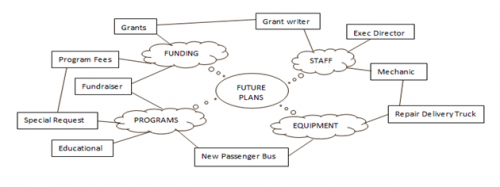Generate ideas by focusing on the concept of visual learning
Use radiant thinking and mind mapping to create a visual image of ideas related to a central issue or concern.
How can we better understand relationships between ideas if we simply list thoughts on a flip chart? Consider a new and unique way to generate ideas by focusing on visual learning to promote creativity and systems thinking.
In visual learning, people tend to:
- Turn notes into graphs, charts, pictures
- Learn by seeing information rather than hearing lectures
- Learn the big picture first and then focus on the details
- Make mind maps and concept maps instead of outlines
A Mind Map is a creative visual image of ideas using lines and circles to organize thoughts in order to see how they are related. It is used to generate ideas through radiant thinking, a natural function of the human mind. A mind map focuses on a central thought, topic, question or image. Associated ideas and suggestions from group discussion are added to the map in radiant fashion which builds on the initial topic.
A mind map has four essential characteristics:
- The key concept is illustrated in a central image
- Primary themes radiate from the central image on branches
- Branches hold a key image/word printed on the associated line - details radiate out
- When the branches form an interconnected structure they depict relationships
How exactly is mind mapping used to generate ideas? Start by hanging a long roll of paper on a wall in the front of the room. Explain to participants that they will create a “mind map” to generate ideas (e.g., goals for the group, or brainstorm ideas for action on an important issue).
Agree on the central topic, question or issue. If using this tool for strategic planning, the topic may be something like, “What major tasks do we want to accomplish in the next year?” Write a key phrase in the center of the paper and draw a circle around it. You may begin with categories on the outside edges of the paper, or categories may emerge as ideas are mapped.
Ask participants to take a few minutes to silently write down their ideas. Then ask each person to contribute one idea in round robin style. Write the idea on the paper, drawing a line outward from the central topic. Lines can also be drawn from these ideas to other closely related sub-ideas that might emerge. As new ideas are given, either draw a new line, or add the idea somewhere along an existing line. Participants should help direct this mapping process. Ideas are organized by the group as they are added to the map. Keep asking each person for new ideas until all have been mapped. The mind map may look something like this:

Discuss the results with participants. Ask questions such as “What does this map mean for/to you?” “How can it help us as we move forward?” “Do you see important relationships or themes between ideas?”
The next steps are to prioritize within the individual category areas, especially if using a mind map to generate a plan of action. Use a visual voting procedure, such as a version of sticky dots to complete the process.
The Michigan State University Extension Leadership and Community Engagement programs engage participants in learning how to effectively manage conflict, communicate with purpose, and collaborate on solving complex issues in order to move communities forward.



 Print
Print Email
Email


